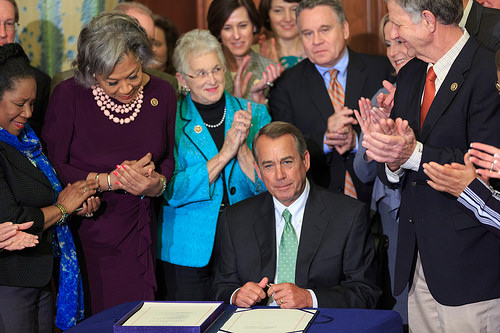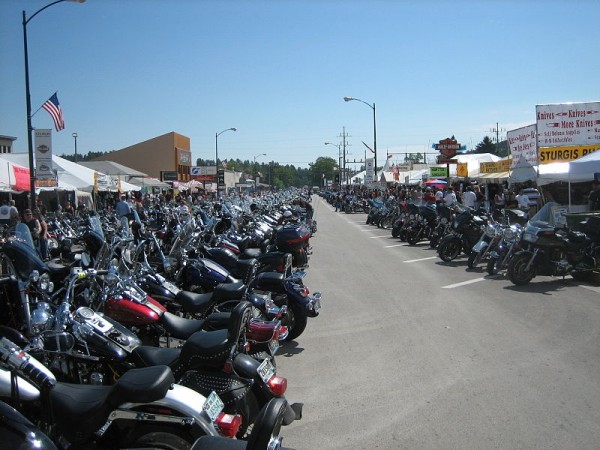
This year, Congress decided that the term “john sting” needed a rebrand. What, they wondered, would justify all the wasted resources and manpower under a veil of moral indignation? After they put their collective hive mind together, a new, shinier, more bureaucratic term emerged. John stings are now called federally funded anti-trafficking work.
The change came earlier this year when Congress further institutionalized End Demand-style tactics by expanding the definition of who can be charged with human trafficking to include those seeking services from sex workers. And the way that these practices are being implemented is moving anti-trafficking work even further from addressing victimization—moving away from victims all together, in fact.
In discussions of trafficking legislation this year, it is impossible not to talk about the Justice for Victims of Trafficking Act (JVTA). The omnibus bill, which set off fires about both abortion funding and the confirmation of Attorney General Loretta Lynch, was signed into law in July, covering a range of trafficking-related issues. Currently, the law exists only on paper while officials and advocates debate how to enact it. While some aspects of the law have existing practices to draw from (for example, removing past prostitution convictions for trafficking victims is possible in New York and a handful of other states), others remain completely untested.
There is one provision that inspired much debate behind the scenes, but received almost no discussion in the media. The bill vastly expands the definition of what constitutes a trafficker. Currently, the definition of trafficking in the JVTA is broken into two categories: sex trafficking (the sex trade only) and labor trafficking (everything else). The definition of the crime lists a number of verbs, things you must do to do be prosecuted as a trafficker. To be a trafficker, one needs to participate in the “recruitment, harboring, transportation, provision, or obtaining of a person for labor or services, through the use of force, fraud, or coercion…” The special caveat is that for those under the age of 18 in the sex trade, there does not need to be force, fraud or coercion. This means that all minors trading sex, regardless of their circumstances, are legally considered trafficking victims, and everyone around them is a trafficker.
Under the JVTA, this list now includes the crimes of “patronizing” and “soliciting” a trafficking victim—but only someone trafficked into the sex trade. Sorry, trafficked nail salon and restaurant workers! And because of varying laws and legal precedents, it’s also unclear how much the courts would require someone to know about the situation, or the age of the person they were contacting, to be prosecuted. This two-word addition to the federal definition of trafficking means that End Demand tactics that criminalize buyers are now being institutionalized in federal law, and those who patronize sex workers are now considered on the same level as actual human traffickers who knowingly force women to work without pay under threat of harm.
Not only is this a vast expansion of who can be arrested for the crime of trafficking, but it expands the very concept of what trafficking means. This is a huge departure from what was originally envisioned as trafficking in persons. It further distances the idea of trafficking from a crime that involves the abuse of another person. Furthermore, it makes everyone involved in the sale of sex an accessory. Criminal justice is commonly criticized for focusing on punishment as more important than the support of victims. But this expansion is not even criminal justice, but simply pure criminalization.
What is more insidious, and far more dangerous to people in the sex trade and trafficking victims in general, is how these tactics will work on the ground. That picture is a dire one for the future of anti-trafficking work. Actual traffickers will be less likely to be caught as inflated numbers of “traffickers”—actually just people seeking sexual services—are reported by law enforcement.
A Problem in Practice
This two-word inclusion has disturbing and far-reaching ramifications. Instead of undertaking the challenging, complex process of investigating exploitation and violence, law enforcement is now being encouraged to conduct john stings. There has been plenty of discussion on how end demand tactics negatively impact sex workers, and now they will be diverting even more resources from addressing real issues.

For the third year in a row, South Dakota has shown us exactly what this new definition of trafficking looks like in action. Since 2013, there has been an annual internet-based john sting at the Sturgis Motocross Rally in South Dakota. While in many places, responding to a fake ad for someone 18 or 20 years old will result in a fine and possibly a trip to a day-long john shaming program, at the Sturgis Motocross Rally, it’ll get you a federal felony, a lengthy prison sentence, and years afterwards on probation and the sex offender registry.
In the stings, law enforcement places an ad for someone over the age of 18 on Backpage or Craigslist, and just like they do in any episode of To Catch a Predator, they exchange texts under the guise of setting up a meeting. At some point in the conversation, the age of the poster changes to someone under the age of 18 and, as you can imagine, responses vary. When the individual meets with the cop-playing-pimp, he is arrested and charged.
Often it begins with a state charge of solicitation of a minor. Later, this charge turns into the federal felony of attempted sex trafficking.
That’s right—no crime against a trafficking victim. No interaction with a trafficking victim. No trafficking victim. Despite agencies like the Department of Homeland Security saying they use a victim-centered approach, anti-trafficking work is now happening without a victim, an attempt to find a victim, or even the intention to find a victim. The very thought of patronizing someone in the sex trade is now a federal crime that carries penalties which have ranged from three to fifteen years.
Over the last three years, 19 men have been arrested/charged and 15 have been sentenced through these stings, with the most recent sting occurring only this month.
What makes this year unique, and all the more troubling, is that the charges in 2013 and 2014 seemed to be an aberration based on an expansive reading of trafficking law. Legal challenges were made against them and some are still working their way through the courts. But with the passage of the JVTA, this aberration became standard operating practice by being codified into federal law. What seemed like a drastic step has now become a sanctioned anti-trafficking effort.
These stings are also an egregious misuse of anti-trafficking resources. Trafficking into labor sectors such as domestic work and farm work is significantly more prevalent than trafficking into the sex trade. Trafficking advocates have asked law enforcement for years to prioritize these industries, but arresting sex workers and their patrons is faster and easier—after all, they’ve been doing it for ages. And these arrests often lead to more prosecutions than time-intensive and complex labor cases. While this year’s sting at the Sturgis motorcycle rally had four arrests, the recent federal case revolving around trafficked shipyard guest workers from India, which involved hundreds of workers, has had zero arrests or convictions.
In 2014, the arrest of one non-violent person involved a law enforcement officer playing the pimp, a six person take-down team, and at least two surveillance officers at the location. This doesn’t even account for the team required to plan and manage the logistics of the sting or the texting back and forth in the days leading up to the arrest. These efforts compound the cost of the sting by requiring the operation of a multi-level task force involving local and federal agencies. This also doesn’t take into account the time it takes for prosecutors and DAs to try the cases, some of which are still on appeals over a year later. Nor does it count the cost of incarceration: the 14 people currently sentenced will be imprisoned for a collective 72 years, many with years-long supervised release to follow.
And at no point was there even an intention to find a trafficking victim. As a side-note, while state police officers focus on crimes against children in which no children are in fact involved, South Dakota currently has a child poverty rate of 18.2% and is experiencing historic numbers of youth homelessness.
Anti-trafficking work is complicated. Exploitation, violence, and trafficking are all nuanced experiences which often disproportionately impact criminalized and marginalized populations. Anti-trafficking work taps into a range of sociocultural challenges and oftentimes operates in the gaps between our social safety nets and an individual’s needs. Thousands more words could be written about how stings harm sex workers, interfering with the harm reduction techniques they use to stay safe. But the Sturgis Motocross Rally operation is the perfect example of the farce that anti-trafficking work has become: the spectre of an idea of a trafficking victim is enough to increase policing and incarceration, and those in the sex trade, including trafficking victims, are the collateral damage.
The South Dakota stings sound like a textbook definition of entrapment.
North Dakota does john stings similar to South Dakota. According to a couple of detailed news articles describing stings in North Dakota, the process goes like this:
1) Police place prostitution ads. The ads don’t suggest that the prostitutes are under age.
2) When men respond to the ads, the police tell them that the prostitutes are under age.
3) The description of one sting said that “hundreds” of men responded to the ads, but the vast majority of them ended the conversation when police told them the prostitutes were under age. Only eleven men continued and attempted to hire an underage prostitute. The other sting described had similar results.
It was obvious from the descriptions that all of the men who responded to the ads thought the ads were for legal adults. Only a tiny percentage of the responders were interested in underage prostitutes. But the North Dakota Attorney General cited the responses as proof that there’s a large market for underage prostitutes in North Dakota.
I checked the sex offender lists for several locations in North Dakota. In almost every instance, the offenders knew their victims; either family or friends of family. I didn’t find any instances of an offender finding a victim through advertising, either on the web or through some other media. Using publicly available records, I wasn’t able to find evidence of organized trafficking of legal minors that used web or print advertising to find customers in North Dakota.
A woman who worked as a victim specialist for the FBI resident agency in Minot said that she had a sudden increase in trafficking victims, but none of them were underage. The Minot resident agency covers much of the Bakken oil fields, which is supposedly where North Dakota is experiencing an increase in underage trafficking.
Great post.
You did a terrific job! This post sound very wonderful.